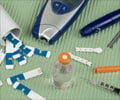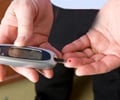A simple new score for predicting the risk of type 2 diabetes could be used to identify people at high risk of diabetes and proactively intervene before they develop the disease, concludes a large study published on bmj.com today.
The score uses information that is available in electronic health records, or which patients themselves would be likely to know, and does not require laboratory tests, so can be used in routine clinical practice, by national screening programmes, and also by the public (http://www.qdscore.org).The prevalence of type 2 diabetes has increased rapidly worldwide, fuelled by ageing populations, poor diet, and the obesity epidemic. Early detection is crucial, yet no widely accepted risk prediction score has been developed and validated for use in routine clinical practice.
So a team of researchers from the Universities of Nottingham, Edinburgh, Queen Mary’s and NHS Bristol, set out to develop and validate a new diabetes risk algorithm (the QDScore) to estimate the risk of acquiring type 2 diabetes over a 10 year period, using the QResearch database.
They analysed the health records of over 2.5 million patients registered at 355 general practices across England and Wales over a period of 10 years to March 2008. All participants were aged between 25 and 79 and were free of diabetes at the start of the study.
Patients who were diagnosed with type 2 diabetes during the study period were identified from the general practice computer records.
After adjusting for all other variables, the risk of being diagnosed as having type 2 diabetes in both men and women was significantly associated with age, sex, ethnicity, body mass index, smoking status, family history of diabetes, social deprivation, treated high blood pressure, heart disease and use of corticosteroids.
Advertisement
They also found a marked difference in rates of type 2 diabetes by social deprivation, with women in the most deprived fifth more than twice as likely to develop diabetes than compared with the most affluent fifth. A similar, but less steep gradient was seen for men.
Advertisement
The QDScore also performed well when compared with another diabetes risk algorithm, known as the Cambridge risk score.
The QDScore is the first risk prediction algorithm to estimate the 10 year risk of diabetes using both ethnicity and social deprivation, say the authors. It does not need laboratory tests and thus is suitable for use in both clinical settings and also by the public. Furthermore, it is likely to reduce, rather than exacerbate, widespread and persistent health inequalities, they conclude.
The QDScore appears highly accurate and practical, and could be used to identify patients with an increased risk of diabetes, which might lead to earlier diagnosis and intervention, say doctors from the University of Dresden in an accompanying editorial.
Incorporation of the QDScore into practice computer programmes would not increase doctors’ daily workload, but they point out that computer access is essential, which may be difficult for people in most developing countries.
Several organisations have recommended the use of a prediction algorithm in primary care in Europe and the QDScore will be a useful tool to help achieve these goals, they write. However, they suggest that follow-up studies are needed to assess the success of the QDScore.
Source-BMJ
SRM













